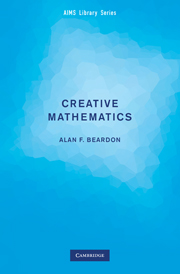18 - Problem C: Discussion and Generalisations
Published online by Cambridge University Press: 16 May 2024
Summary
It is clear that given n discs, and without identifying any patterns, there are 2n possible starting patterns. Thus, regardless of the starting pattern, one of the patternswill eventually be repeated, and after that the patterns will occur periodically.
We need a mathematical formulation of the problem, and this is often the hardest part of problem solving. In general, given a system in which there are exactly two choices, we should always consider using arithmetic modulo 2. Let us now represent the red discs by 0, and the blue discs by 1. Then any state of the system is a vector of length n with each component 0 or 1, and where two vectors are considered to be the same if one can be cyclically permuted into the other. With this notation, the rules for replacement become: between 0 and 1, and between 1 and 0, we put 1; between two 0s, and between two 1s, we put 0. We can denote these rules symbolically by
It should now be clear that the move from one pattern to the next is given by the map
and this is our mathematical formulation of the problem. As this map is a linear map it can be written in matrix form, namely
where again the arithmetic is modulo 2. Let us denote the matrix of coefficients by A. Then, if we start with the pattern (x1, … , xn) and apply the process m times, the resulting pattern will be
This observation easily enables us to check many cases on a computer. For example, if we start with the pattern (R, R,B, R,B) and apply the process 13 times, the final pattern will be (B, B, B, B,R) because (using a computer)
A warning is appropriate here. If we compute An for a large n, and then reduce the resulting matrix modulo 2, the answer may not be correct because there may be errors in computing An. The correct procedure is to reduce the answer modulo 2 after each product.
We now prove some general results about these patterns and, for brevity, we shall use the same symbol, say x, for both a (row) vector and its transpose (a column vector).
- Type
- Chapter
- Information
- Creative MathematicsA Gateway to Research, pp. 79 - 82Publisher: Cambridge University PressPrint publication year: 2009



